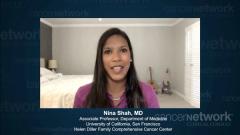
Navigating Individual Treatment for Relapsed/Refractory Multiple Myeloma
Nina Shah, MD, discusses how to properly navigate treatment plans for patients with relapsed/refractory multiple myeloma.
Episodes in this series

Nina Shah, MD: When treating patients with relapsed or refractory multiple myeloma, [there] is never a set way for every patient. It’s a pathway you have to [determine] individually for each patient. The most important thing that we think about the next regimen, particularly in the later lines, is what have they had before, how do they respond to it, and what toxicities did they have? Most of our patients, by the time they get to be heavily pretreated, for example with 3 lines, will have had bortezomib [Velcade], lenalidomide [Revlimid], dexamethasone [and] either isatuximab [Sarclisa] or daratumumab, pomalidomide [Pomalyst], and carfilzomib [Kyprolis]. Those drugs, which I would consider the big drugs for this disease, will already have been used up by the time we get to the late relapses. Now we’re looking at novel mechanisms of action as well as things that are well tolerated. Because of this, I’m very excited about the upcoming BCMA [B-cell maturation antigen]–directed therapies. Number 1, the CAR T-cell therapy of which one is approved, and hopefully another one will be early in 2022. In addition, I think that bispecific T-cell engagers are really going to make a splash when and if they’re FDA approved. The reason for this is that they are off-the-shelf immunotherapies and all of the data that has been presented, even in phase 1, suggest that these are well tolerated, even for our older patients. You can imagine a scenario where patients can get infusions or injections of these therapies, potentially the first or second dose in the hospital very closely managed, because there is at least a 60% to 70% chance of CRS [cytokine release syndrome] in the first 1 or 2 doses. But after that, they could go to their clinic and get serial treatment and don’t have to go to a big academic center. That’s really going to make a splash on the scene.
The other drugs I’m very excited about include talquetamab [JNJ-64407564], which is a bispecific T-cell engager against GPRC5D, as well as tafasitamab [Monjuvi], [which is] another bispecific T-cell engager that gets FcRH5. These will address BCMA failures or people who have failed after being treated with a BCMA-targeted agent. In addition, there are a lot of new data with CELMoDs [cereblon E3 ligase modulators]. These are the drugs that we’ve known for so long, but there are new formulations of them and new engineered molecules for these particular agents. They are showing a nice response in combination with either dexamethasone or in combination with daratumumab or bortezomib in the relapsed or refractory setting. The good thing about these drugs is they’re [taken orally], so that’s something that you could really think about giving your patients off the shelf. We really look forward to seeing not only how the patients are doing as far as a response, but how they’re tolerating them from a toxicity perspective.
Newsletter
Stay up to date on recent advances in the multidisciplinary approach to cancer.


















































































